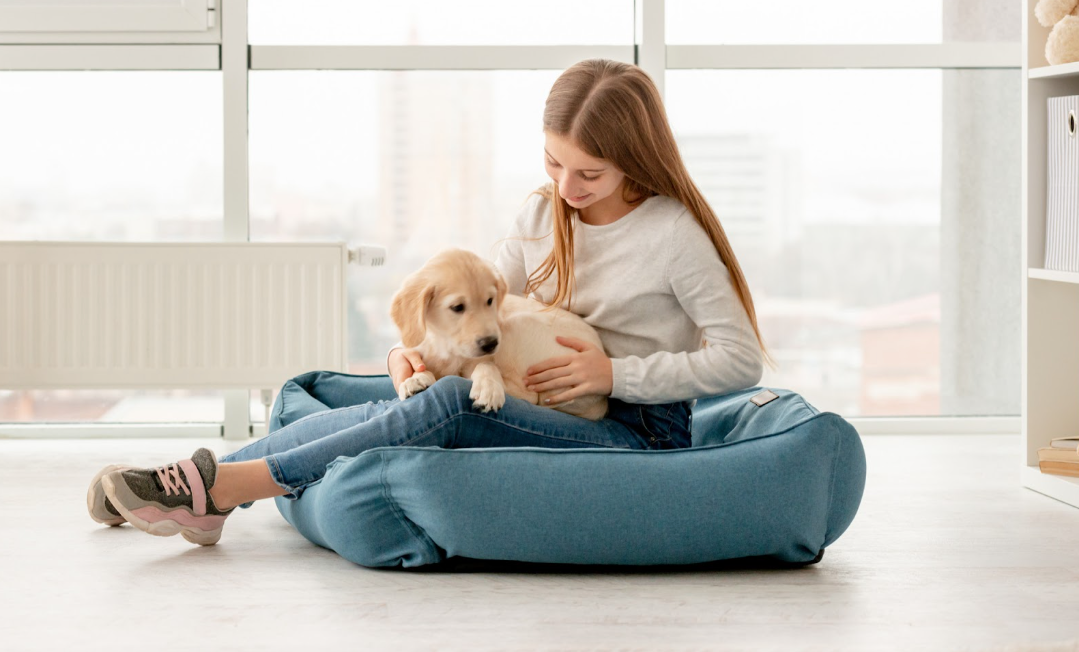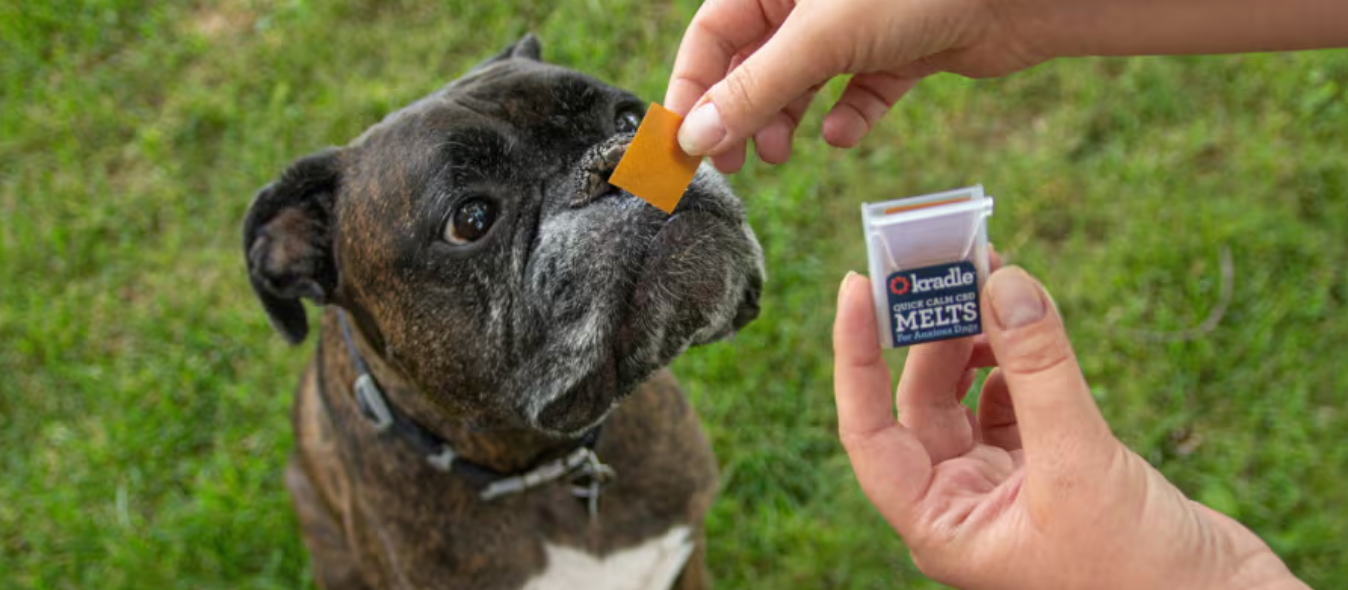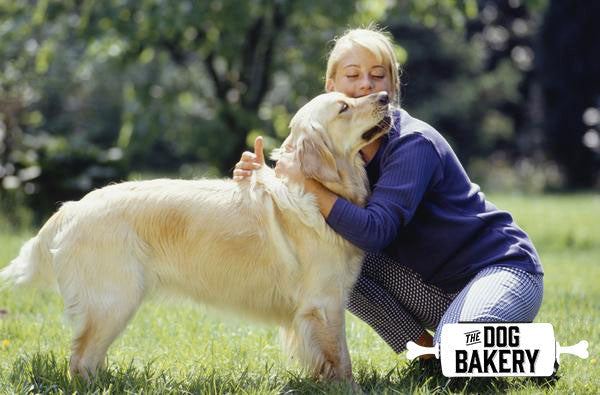
Many dogs get full run of their human counterparts home - their bed and couch included. But even those regulated to the ground and their own pup beds are still tracking their little paws all over your home. So you might be wondering just how often your dog needs a bath, for their own hygiene and for the sake of your belongings. While this is a topic always up for debate amongst dog groups (some swear by washing weekly, others say they’ve never washed their pup and that’s just fine), we thought it might be helpful to offer up some general guidelines on how often you should bathe your dogs and cats, including the items they come in contact with like beds, food bowls, leashes and more! See our thoughts below:
 Photo by @molly_bemolle on Instagram
Photo by @molly_bemolle on Instagram
How often to bathe: The general consensus here seems to be that unless your dog has skin problems (in which case you should consult your vet on best bathing practices), how often you give your dog a bath is really up to you! Many people with non-oily dog breeds wash their dogs about once a month, while more oily breeds are bathed on a more regular schedule.
Dr. Sherry Weaver writes on CesarsWay.com, “I recommend you bathe a dog with normal skin once a month with dog shampoo or human baby shampoo. If you want to bathe more often than once a month, use a soap-free or moisturizing shampoo to prevent the skin from becoming dry. Do not bathe your dog more than once a week, unless recommended by your vet.” You can also read about more specific grooming tips here.
 Photo by @tuskthedog on Instagram
Photo by @tuskthedog on Instagram
What about cats? Cats have built-in grooming tools (tongue and teeth), and are much more efficient than dogs at keeping themselves clean. In a perfect world, you won’t need to worry abou bathing them, and can take them into a groomer if they need anything that they will fight you on. Brushing your cat not only removes dirt, grease and dead hair from their coat, but it helps to remove skin flakes and stimulates blood circulation, improving the overall condition of the skin. One or two brushings per week will help kitty to keep a healthy glow—and you’ll find that regular sessions are especially beneficial when your cat ages and is no longer able to groom so meticulously on their own. The ASPCA has further tips on cat bathing and grooming at home!
 Photo by @minou.and.atheon
Photo by @minou.and.atheon
Beds: Most people report washing their pets beds once a month, moreso if you live in a wooded area or your dog gets dirty more often. You can simply remove the outer cover and wash and dry the bed linen in your own washer/dryer. The bed base can often be washed this way too. Wash separately from other laundry or minimally with like colors. Use a large load setting, cold water, and plenty of clearly marked pet-safe laundry detergent to aid in dislodging as much pet hair and dirt as possible. Repeat the wash cycle for especially dirty beds. Dry the washed bedding in the clothes dryer with at least one clearly marked pet-safe dryer sheet. The dryer sheet will reduce static electricity and remove excess pet hair. Dry on a low temperature setting for 20 minutes to remove hair and wrinkles, then air dry to avoid shrinking the bed. Again, be sure to check the label of your laundry detergent & dryer sheets to ensure it is pet-safe! Want to clean more often? Thoroughly vacuum the bed to remove excess hair, dirt, and other debris. Roll a lint roller over the bed to pull away hairs that the vacuum missed. How to wash a dog bed should be a primary consideration when you are selecting from the range of commercially available dog beds at your local pet or department store. Check the tags on dog beds to see whether the recommended method of cleaning is feasible and practical for you, your home, and the time you have for cleaning. All too often, people buy a dog bed on impulse because it is cute or it fits with their home decor. It won’t be so cute when you go to wash it and find out it’s a pain in the butt to get clean!
 Photo by @daniellemoss_ on Instagram
Photo by @daniellemoss_ on Instagram
Food Bowls: Did you know - NSF International, a public health organization, rated food bowls as the fourth dirtiest spot in our homes. Eeep! We love our cats and dogs so much, and we want to keep them happy and healthy. One way to do this is making sure we thoroughly clean our pet’s food and water bowls to help avoid germs, bugs and mold that can make our furry friends sick. Luckily, there are a few great ways to tackle this cleaning process to make sure you’re doing the job right. NSF recommends either placing the bowl in a dishwasher or soaking it for about 10 minutes once a week in a solution of one part bleach to one part water. Then, rinse well and dry. However, if you don’t feel comfortable using bleach, VetStreet recommends cleaning the dish after every meal with hot water and soap. Or better yet, Tina Wismer, DVM, medical director at the ASPCA’s animal poison control center in New York told Wendy Wilson of Cesar's Way to combine equal parts of baking soda, warm water and salt and scrub the surface in a circular motion, and then rinse well.
 Photo by @leonardothefrenchie on Instagram
Photo by @leonardothefrenchie on Instagram
Leashes: Once again, how often you clean your pup's collar and leash will have to do with how dirty they get them. If your dog doesn’t see much outside action, you’re safe to wash infrequently. But if they’re rolling around outside in a leash and/or collar fairly often, it couldn’t hurt to give these items a good cleaning once a month. Most collars and leashes can be thrown in the dishwasher or clothing washer, but you can read about handmade ways to clean here. A good rule of thumb is to wash your dogs collar at least as often as you wash them! Who wants to put a dirty collar back on a clean pup?
 Photo by @sochi_the_siberian on Instagram
Photo by @sochi_the_siberian on Instagram
Toys: Although you might not think about cleaning your pet's toys, depending on how quickly they go through them, it can be an added bonus that results in a cleaner toy bin. If your dog is the type who is on a mission to gut anything with a squeaker or stuffing, then there's a good chance your toys don't actually last long enough to necessitate a washing. If you have some favorites sticking around though, and especially if there are young children around, you might consider giving toys that live on the floor a good cleaning. Although babies and dogs alike are quite resilient, there's something about a toy box filled with crusty drool-laden toys that says it's time for a quick freshening up. For cloth toys, they are best washed on cold in your washing machine, after being placed in a delicate garment bag. Make sure to reduce the amount of soap you use, assuming the washer won't be 100% full of toys. If so, it could be time to give a once over and do some purging! When in doubt on how much soap to use, less is better. Once done, remove from the wash and squeeze remaining water out. If you have the ability to line dry, pin them all up and give them an hour or so in the sun to dry out. Placing them in the dryer is just fine, make sure it's on low heat and if you're worried about them, place them inside a pillow case. If you have plastic toys, use a solution of 50% white vinegar to 50% water and allow them to soak for 30 minutes. Remove and use a nail brush to scrub the dirt off, rinse with fresh water and allow to dry. Tennis balls can go in the wash, however they do require a bit of funk to make them safe for pets.
 Photo by @baileythevizsla
Photo by @baileythevizsla
How often you clean your floors (whether you have hardwood or carpet) is really up to you. This will likely be determined by how much your pet sheds, how much dirt they’re dragging in from outside and how often you like to clean your house usually anyways. Again, these are all general guidelines based on varying ideals about how to keep your animals and home clean. Doing the research and thinking through what’s best for you and your family is usually best practice in these sorts of matters. That being said, we’d really love to hear your cleaning routines in the comments below!






